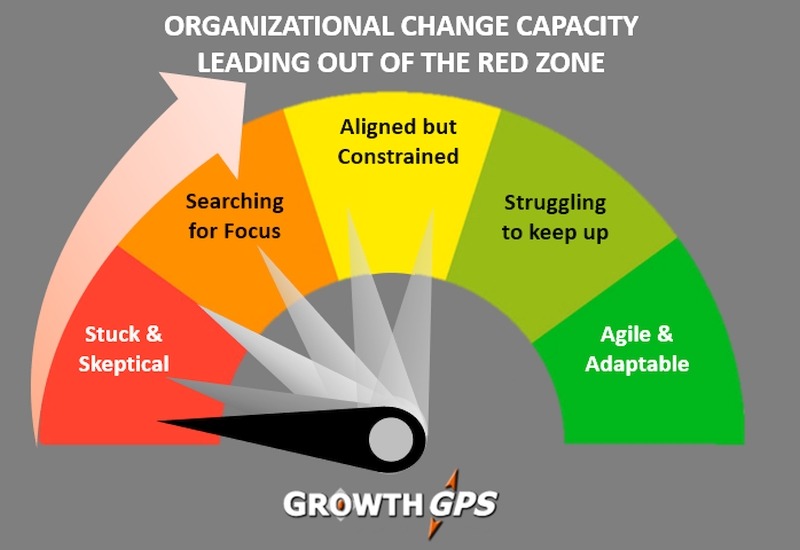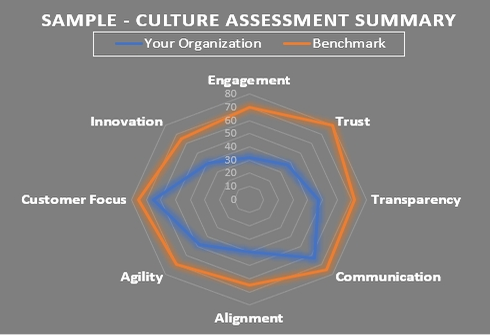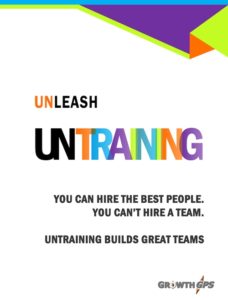HIGHLIGHTS:
- Companies with the least capacity for change are “stuck & skeptical”
- Leading an organization out of a change-resistant state requires unorthodox approaches
- Adapting is key to survival and success in today’s fast-paced, unpredictable business landscape
- Measure your organization’s change capacity with our exclusive Organizational Change Capacity tool
If your organization resists change, chances are your team is on the left side of our Change Readiness gauge (shown). Not a healthy place to be in today’s business landscape driven by ever-increasing speed of change and unpredictability of the change direction. There’s a good reason pivot and disruption are critical business terms.
If your organization resists even the simplest of changes, your team is likely in the red zone – “stuck and skeptical.”
The Stuck & Skeptical Organization
The stuck & skeptical organization is often weak in connection, scaling and action. These firms usually have a history of success, but time has taken a toll, and change is limited to the local level. Company-wide initiatives aren’t talked about much, rarely getting beyond the talking stage.
People become skeptical when they lack –
- Trust in leadership
- Transparency of communication
- Confidence in where the company is headed
- Action on simple changes that are obvious to anyone paying attention
Skepticism is magnified when people see their hard work having little impact. Some employees rally to meet an unusually demanding customer requirement now and then, but they aren’t reinforced with others doing the same on a regular basis. Your best employees become weary being the go-to heroes who save the day, growing resentful when expected to go above-and-beyond when others don’t.
The skeptics want to see change. Often your best workers, skeptics grow impatient with the slow pace of change, and likewise with leaders who often lack urgency to make changes that seem obvious to those doing the work. When your best workers feel trapped on the treadmill, you’re in the red zone.
How to Lead the Stuck & Skeptical Organization Forward
No single leader can lift a whole company out of this state. Success comes only by reigniting the enthusiasm of the team, which starts with demonstrating quick wins from small changes. Wins on the board build energy, enthusiasm and participation.
The challenge: where do you find those wins?
Since the skeptics lack trust in leaders and confidence in where the company is headed, often the best approach is to turn to the tables –
- Invite employees to share their ideas for what to change
- Empower them to make the changes they want
- Recognize people for trying new things
- Celebrate successful changes, even the very smallest ones
- Identify how those changes make a lasting impact on the company or its customers
As the organization chalks up one win after another, the most skeptical of skeptics usually joins in – that’s when real momentum builds. At that point, you’re out of the “stuck & skeptical” red zone and ready to develop stronger organizational change capacity.
Want to jumpstart your organization’s change?
DISCOVER YOUR FIRM’S CHANGE CAPACITY AND BOOST IT WITH A-D-A-P-T™
Case Study – from Stuck to Showcase
A $350M division of a global Aerospace manufacturer became unprofitable 4 years after purchase. The division’s 1,800 jobs were on the line if they couldn’t turn a profit within 2 years. The General Manager had recently been sent to the division’s main plant from headquarters in Europe, charged with making changes necessary to return the plant to a healthy profitable condition.
During a discovery meeting, we learned the new GM was the fourth in as many years, and that 5 KPIs were so far below acceptable that customers were asking hard questions, putting the company on the defensive. Things like 13% on-time Delivery, 24% Customer Quality Rejects. It’s no wonder the plant was unprofitable.
Digging behind the numbers, we discovered a non-reported metric to be the root cause of most of the issues:
- 29% Employee turnover, 2 years in a row
Imagine – Over 500 out of 1800 people had been replaced 2 years in a row! Interviewing, hiring and training absorbed management’s time and attention – rarely could they focus on actually running the business.
Growth GPS Solution
Growth GPS approaches operational issues as people issues first, rather than focusing on processes or systems like most performance consultants. With an unconventional 5-phase project, we helped save the plant and return it to profitability in under 18 months.
Here’s how we jumpstarted the firm’s momentum, digging out from “stuck & skeptical.”
Phase 1 – Assessment – Employee Survey
Our employee survey surfaced deep-seated issues, including 2 key insights behind the 29% employee turnover:
 Trust was significantly below Gallup benchmark (results similar to sample shown), reflecting new management parachuting in from HQ annually;
Trust was significantly below Gallup benchmark (results similar to sample shown), reflecting new management parachuting in from HQ annually;- Engagement was low because employees lived an overly-controlling culture, taking away motivation to perform for managers who didn’t understand the operation because they were short-timers.
Bottom line: employees were the “keepers” of the operation, blamed by corporate for sliding performance while being overly-managed by people unfamiliar and lacking commitment to make lasting improvements. Longer-term plant employees described what needed to change to return the division to success, but they felt handcuffed.
These insights led to our project goal: build engagement and trust by empowering the long-term employees to do what they knew worked.
MORE ABOUT ORGANIZATIONAL ASSESSMENTS
Phase 2 – Engagement & Change – MAD Teams™
To signal change and respect for the employees based on their feedback, we needed the GM and all the managers to take a leap of faith with us: to release the tight controls they believed would boost performance, embrace employee ideas for change. Our MAD Teams process is designed to build trust through engagement by challenging employees to share ideas that “Make A Difference,” and collaborating to implement the ideas.
We held 46 Idea Workshops with about 1500 participants that delivered over 2000 ideas. Of those –
- 100 teams with 700 employees pitched their ideas “shark tank style” to leadership
- 25 teams (about 200 employees) given the go-ahead to pilot ideas with $1,000 budget each
The breadth of ideas ran from simple to complex, ideas as pragmatic as they come. While managers somewhat jokingly expected employee to suggest things like ping-pong tables in the lunchroom and beer Fridays, they heard the exact opposite. Hard-hitting ideas that went right to the root cause issues – from making the employee onboarding process far more robust, to re-instituting regular training for all employees, to making operational changes like rearranging tooling locations.
The managers were so impressed by the ideas, they sponsored the employee MAD Teams to fully implement every pilot that worked out. Talk about employee engagement!
HOW MAD TEAMS™ DRIVE EMPLOYEE ENGAGEMENT & CHANGE
Phases 3, 4 and 5 featured a variety of Leadership Training workshops designed to foster behavior changes at the manager, supervisor and team leader levels in support of a more Collaborative Culture. Unconventional bottom-up change has to be supported with changes at every level of leadership in order to sustain.
LEARN ABOUT OUR INNOVATIVE LEADERSHIP TRAINING
Impact – from Stuck to Showcase
After 5 quarters, our project was deemed a significant success: the plant was profitable, 1,800 jobs were saved, the division delivered its best Quarter in nearly 15 years, and all 5 root-cause KPIs that we targeted improved dramatically. Get this: the division is now the corporate showcase used for tours with new potential customers!
DISCOVER YOUR FIRM’S CHANGE CAPACITY AND BOOST IT WITH A-D-A-P-T™

